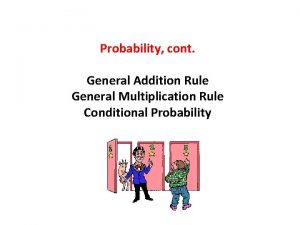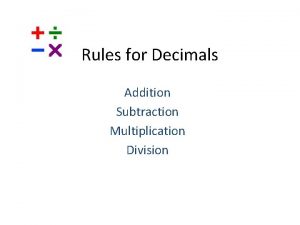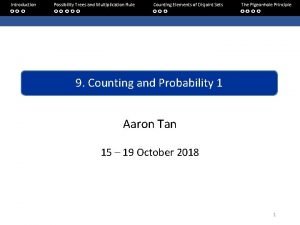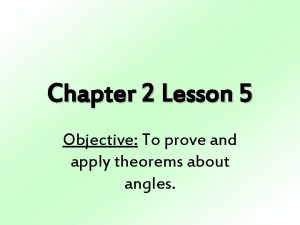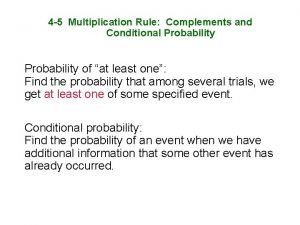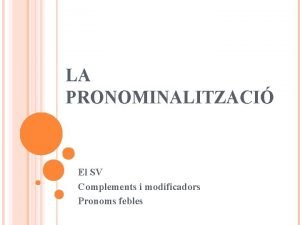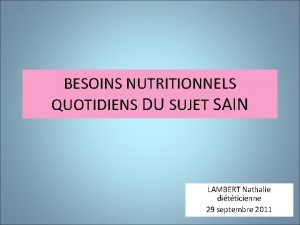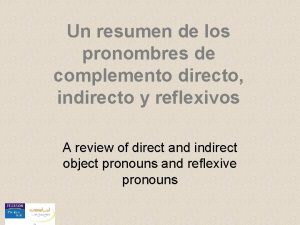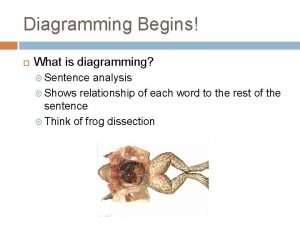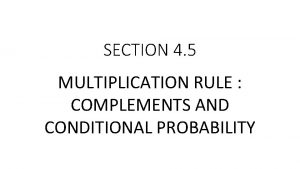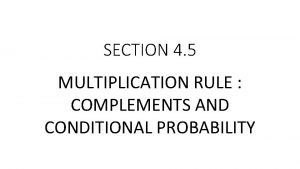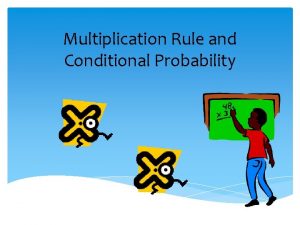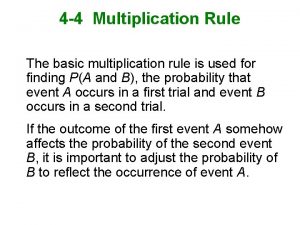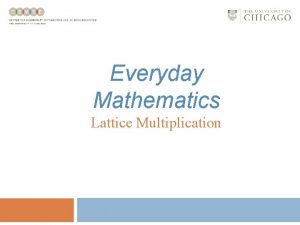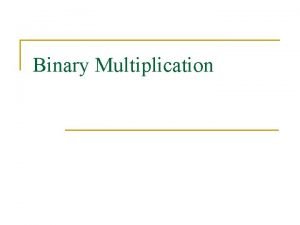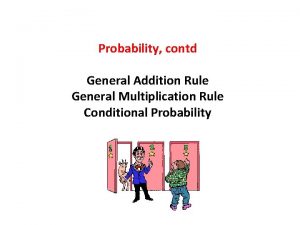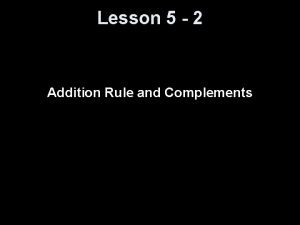Section 4 5 The Multiplication Rule Complements and


























- Slides: 26

Section 4 -5 The Multiplication Rule: Complements and Conditional Probability

Learning Targets Probability of “at least one”: Find the probability that among several trials, we get at least one of some specified event. Conditional probability: Find the probability of an event when we have additional information that some other event has already occurred.

Learning Objectives Probability of “at least 1” Formula for Conditional Probability v “At least one” is equivalent to “one or more. ” v The complement of getting at least one item of a particular type is that you get no items of that type.

Practice Problem

Finding the Probability of “At Least One” To find the probability of at least one of something, calculate the probability of none, then subtract that result from 1. That is, P(at least one) = 1 – P(none).

Practice Problem

Example

Conditional Probability A conditional probability of an event is a probability obtained with the additional information that some other event has already occurred. P(B | A) denotes the conditional probability of event B occurring, given that event A has already occurred, and it can be found by dividing the probability of events A and B both occurring by the probability of event A:

Intuitive Approach to Conditional Probability The conditional probability of B given A can be found by assuming that event A has occurred, and then calculating the probability that event B will occur.

Confusion of the Inverse To incorrectly believe that P(A|B) and P(B|A) are the same, or to incorrectly use one value for the other, is often called confusion of the inverse.

Example

Example

More Practice

Example: Find the probability of a couple having a baby girl when their fourth child is born, given that the first three children were all girls. Is the result the same as the probability of getting four girls among four children? 0. 5. No.


Challenge Problem Results from Experiments with Polygraph Instruments Did the subjects actually lie? No (did Not Lie) Yes (Lied) Positive test result 15 42 (Polygraph test indicated that the subject lied. ) (false positive) (true positive) Negative test result 32 9 (Polygraph test indicated that the subject did not lie. ) (true negative) (false negative)

More Practice - Your Turn Use the information in the table below to answer the following question. Assume that 1 of the 98 test subjects is randomly selected. Find the probability of selecting a subject with a positive test result, given that the subject did not lie. Results from Experiments with Polygraph Instruments Did the subjects actually lie? No (did Not Lie) Yes (Lied) Positive test result 15 42 (Polygraph test indicated that the subject lied. ) (false positive) (true positive) Negative test result 32 9 (Polygraph test indicated that the subject did not lie. ) (true negative) (false negative)

Results from Experiments with Polygraph Instruments Did the subjects actually lie? No (did Not Lie) Yes (Lied) Positive test result 15 42 (Polygraph test indicated that the subject lied. ) (false positive) (true positive) Negative test result 32 9 (Polygraph test indicated that the subject did not lie. ) (true negative) (false negative) Knowing that they did not lie means that we will only look at those people. Of those 47 people, only 15 of them had positive test results. Therefore, the probability is:

More Practice

More Practice

� Sexes of Twins boy/boy boy/girl/boy girl/girl Identical Twins 5 0 0 5 Fraternal Twins 5 5

Example continued: Use the data in the table below. Instead of summarizing observed results, the entries reflect the actual probabilities based on births of twins. Identical twins come from a single egg that splits into two embryos, and fraternal twins are from separate fertilized eggs. The table entries reflect the principle that among sets of twins, 1/3 are identical and 2/3 are fraternal. Also, identical twins must be of the same sex and the sexes are equally likely (approximately), and sexes of fraternal twins are equally likely. Sexes of Twins boy/boy boy/girl/boy girl/girl Identical Twins 5 0 0 5 Fraternal Twins 5 5 b) After studying the sonogram more closely, the physician tells the pregnant woman that she will give birth to twin boys. What is the probability that she will have identical twins? That is, find the probability of identical twins given that the twins consist of two boys. A – twin of 2 boys, B – identical twin

Example 8 continued: Use the data in the table below. Instead of summarizing observed results, the entries reflect the actual probabilities based on births of twins. Identical twins come from a single egg that splits into two embryos, and fraternal twins are from separate fertilized eggs. The table entries reflect the principle that among sets of twins, 1/3 are identical and 2/3 are fraternal. Also, identical twins must be of the same sex and the sexes are equally likely (approximately), and sexes of fraternal twins are equally likely. Sexes of Twins boy/boy boy/girl/boy girl/girl Identical Twins 5 0 0 5 Fraternal Twins 5 5 c) If a pregnant woman is told that she will give birth to fraternal twins, what is the probability that she will have one child of each sex? A – fraternal twin, B – one child of each sex

Example: When testing blood samples for HIV infections, the procedure can be made more efficient and less expensive by combining samples of blood specimens. If samples from three people are combined and the mixture tests negative, we know that all three individual samples are negative. Find the probability of a positive result for three samples combined into one mixture, assuming the probability of an individual blood sample testing positive is 0. 1 (the probability for the “at-risk” population, based on data from the New York State Health Department).

Recap In this section we have discussed: v Concept of “at least one. ” v Conditional probability. v Intuitive approach to conditional probability.

Homework P. 175: 12, 15, 17, 19 -22
 Puppy dog ploy
Puppy dog ploy Simple probability and complements
Simple probability and complements Multiplication and addition rule genetics
Multiplication and addition rule genetics General addition rule example
General addition rule example What is the rule for adding and subtracting decimals
What is the rule for adding and subtracting decimals Counting elements of disjoints sets: the addition rule
Counting elements of disjoints sets: the addition rule Complements to 1
Complements to 1 Intensity to color transformation
Intensity to color transformation Hsi color wheel
Hsi color wheel Congruent complements theorem example
Congruent complements theorem example Conditional probability with complements
Conditional probability with complements How to diagram predicate adjectives
How to diagram predicate adjectives Pollué
Pollué Pronominalització
Pronominalització Els complements verbals
Els complements verbals Linking verb diagramming sentences
Linking verb diagramming sentences Dénutrition
Dénutrition What type of sentence is this
What type of sentence is this Compléments nutritionnels oraux
Compléments nutritionnels oraux 2's complement
2's complement Funcion complemento directo
Funcion complemento directo Como es el objeto directo
Como es el objeto directo Cd determinat
Cd determinat C'est quoi un complement du nom
C'est quoi un complement du nom Diagramming prepositional phrases
Diagramming prepositional phrases Cost minimization perfect complements
Cost minimization perfect complements Complements two
Complements two



